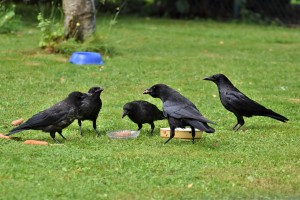
New Delhi: In view of the outbreaks of Avian Influenza (AI) in migratory birds, wild and domestic crow and poultry in certain states of the country, the Ministry of Fisheries, Animal Husbandry and Dairying set up a control room in the national capital in the Department of Animal Husbandry and Dairying, to strategies coordinate and facilitate State Governments with regard to outbreak management, disease control and containment as envisaged in the ‘Action Plan on Preparedness, Control and Containment of Avian Influenza, 2015’.
Infection in humans is not yet reported in India though the disease is zoonotic, the ministry stated. It added that there was no direct evidence that AI viruses could be transmitted to humans via the consumption of contaminated poultry products.
After confirmation of positive samples from ICAR-NIHSAD, AI had been reported from the following States (at 12 epicentres) –
- Rajasthan(crow) – Baran, Kota, Jhalawar
- Madhya Pradesh(crow) – Mandsaur, Indore, Malwa
- Himachal Pradesh (migratory birds) – Kangra
- Kerala (poultry-duck) – Kottayam, Allapuzha (4 epicentres)
Accordingly, an advisory had been issued each to the States of Rajasthan and MP on January 1, 2021, so as to avoid further spread of the infection, the Ministry stated. Another advisory had been issued on January 5, 2021 to Himachal Pradesh where the State had been advised to take measures so as to avoid further spread of disease to poultry. As per the report received, Kerala had already initiated control and containment operations from January 5,20121 at epicentres and culling process is in operation.
The measures suggested to the affected states to contain the disease and prevent further spread as per the Action Plan on Avian Influenza include strengthening the biosecurity of poultry farms, disinfection of affected areas, proper disposal of dead birds/carcasses, timely collection and submission of samples for confirmation and further surveillance, intensification of surveillance plan as well as the general guidelines for prevention of disease spread from affected birds to poultry and human. Coordination with forest department for reporting any unusual mortality of birds was also suggested to the States. The other states have also been told to keep a vigil on any unusual mortality amongst birds and to report immediately to take necessary measures.
“As per the information received from Madhya Pradesh and Rajasthan, control measures are being taken as per the guidelines of National Action Plan of Avian Influenza,” the Ministry stated.
In Kerala, control and containment operation Avian Influenza had been undertaken in villages of Thalavady South, Thakazhi, Pallipad, Karuvattaindistrict of Alappuzha and village of Neendoor in district of Kottayam. As per the report received, a total of 5 registered respiratory therapists (RRTs) had been deployed in above-said four epicentres of district of Alappuzha and 8 RRTs at epicentre Neendoorin district of Kottayam for culling.
A total of 17326 birds (9066 in Pallipad, 8260 in Karuvatta) have thus far been culled and a total of 1570 kg feed have been destroyed in epicentres of district of Alappuzha. At epicenter in district of Kottayam 4229 birds have been culled and a total of 8 kg feed and 42 eggs have been destroyed on 6.01.2021 (Details annexed).
Further, some samples of crow from Kale Hanumanji Forest Nakka, Jaipur, Rajasthan found positive for H5N8 Avian influenza virus. Accordingly, advisories have been issued to the States so as to avoid further spread of disease to poultry. Unusual moralities have been found in 7111 domestic birds in Haryana, 150 wild birds in Madhya Pradesh, 10 crows in Gujarat, 336 migratory birds in Himachal Pradesh today.
As per report received from Haryana, a total of 430267 birds had died in Barwala, panchkula in past 25 days and the samples had been sent to the designated laboratory for testing, the results are still awaited. State has constituted 59 RRTs to control and contain the disease.
“Implementing management practices that incorporate bio security principles, personal hygiene, and cleaning and disinfection protocols, as well as cooking and processing standards, are effective means of controlling the spread of the AI viruses,” the Ministry stated, adding that in view of the past experience regarding the reports of the disease in winter season, periodic advisories had been issued to all states and union territories (UTs ) before commencement of winter for keeping necessary vigil, enhancing surveillance, keeping strategic reserves of supplies (PPE kits, etc.), preparedness to handle eventualities and IEC for public awareness. The last preparatory advisory / communication was issued to all States/UTs on October 22, 2020.
Avian Influenza (AI) viruses have been circulating worldwide for centuries with four known major outbreaks recorded in the last century. India notified the first outbreak of avian influenza in 2006.
In India, the disease spreads mainly by migratory birds coming into India during winter months – largely from September to March. The secondary spread by human handling (through fomites) cannot be ruled out, the ministry stated.
In view of a threat of global outbreak of AI, the Department of Animal Husbandry and Dairying (DAHD), Government of India had prepared an action plan in 2005 which was revised in 2006, 2012 , 2015 and 2021 for guidance of State Government for prevention, control and containment of avian influenza in the country.
Following post operation surveillance plan (POSP) after completion of Avian Influenza outbreak control in 2020 and containment operation at different epicentres, the country freedom from AI was declared with effect from September 30, 2020.
– global bihari bureau





